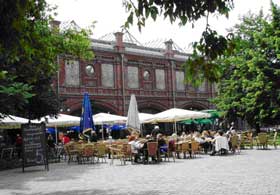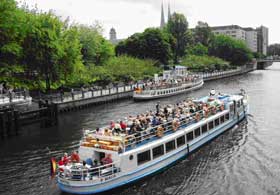
Vol. IV, No. 4, June/July 2005
- Poor indoor air quality plagues many child care centers
- Simple facility upgrades can discourage pests
- Tour of outdoor play environments in Berlin, Germany
- Hazardous materials on your site?
- Making mealtime more homelike
- Ways to avoid injuries in your outdoor play environment
- Nature-deficit disorder
- White Hutchinson chosen to consult on Lincoln's Attic
- Fun Time Early Childhood Academy
- Facilities Design Institute graduates
Tour of outdoor play environments in Berlin, Germany
by Randy White, CEO
In early June, I had the opportunity to travel to Berlin, Germany, for a 4-day study tour of school and public playgrounds (spielplatz), including ones for children with disabilities, youth farms (also called city farms) and adventure playgrounds. The tour was organized by Frode Svane from Oslo, Norway, a landscape architect who specializes in the design of children's outdoor play environments (Children's Landscape Norway). The tour had a total of eight participants from Norway, Germany and Denmark, plus myself from the U.S.
Europeans, and especially the Germans, Danes, Swedes and Norwegians, have a much more advanced concept of children's outdoor play than Americans do. In the U.S., the dominant paradigm continues to be metal or plastic manufactured playground equipment plopped down in the middle of some area void of vegetation. Children's outdoor play areas in Europe are much more organic in design and have copious amounts of vegetation that children can interact with, run through, and hide and gather in. The vegetation is wild, rather than formal. Even the lawns are left to grow wild rather than to be regularly mowed to look like a golf course.
Their playground equipment is mostly asymmetrical and made almost entirely from wood, much of which is not milled lumber, but rather natural shapes with curves and twists. Sand with a hand-operated pump or another device to supply water is a standard feature in every playground we saw. Also, their playgrounds and equipment offer children many more challenges than does the sanitized approach in the U.S., which allegedly avoids any possible injury by making playgrounds and playground equipment risk-free. Europeans believe that offering children increased challenges actually reduces injuries and teaches children how to evaluate risks. Another differentiating feature of many of the Berlin playgrounds we saw was that they incorporated public art. Many of the play features were actually produced by artists.
One area where the U.S. is far more advanced than Germany is in the design of accessible playgrounds. There, the idea is still rather new, and design approaches are in their infancy.
There are over 1,000 schools in Berlin. We saw a number of playgrounds that have been renovated through the consulting work of the municipally funded organization Grün Macht Schule, which has already transformed 400 school playgrounds.
We visited two adventure playgrounds where we saw children between 6 and 16 years old building with saws and hammers and cooking. The adventure playgrounds also offered children metalworking, cooking, and places to do their homework. We saw children being allowed to play with fire in one adventure playground and one public playground. The two youth farms we visited were located in two public parks, right in the heart of neighborhoods. They were free to all and featured animals as well as organized youth activities. Children performed some of the work at the youth farms. In many respects, the youth farms were a public version of agritainment facilities found in the U.S.
I've put together a slide show of some of the 400+ photographs I took on the trip to illustrate the European approach to children's outdoor play. Click here to see the show.
As a closing note, if you are looking for a European city to visit, I highly recommend Berlin. It has many wonderful sights to see, including 138 museums (yes, that number is correct), diverse neighborhoods, a lovely river (Spee) that winds through the city and you can travel by boat, a sophisticated selection of restaurants and cafes, and everything is reasonably priced. I found the city to be very clean and safe. It is incredibly green, the most vegetated city I have ever seen.


I stayed in the Hotel
Juncker's Garni, a small city hotel located in Friedrichshain-Kreuzberg,
a popular neighborhood in downtown Berlin. The hotel cost only 65 Euros
(about $80) a night, including breakfast and taxes. It isn't super
fancy (no air-conditioning), but the staff was nice and the facility very
well kept and clean. The best way to see Berlin is by bike.
Vol. IV, No. 4, June/July 2005
- Poor indoor air quality plagues many child care centers
- Simple facility upgrades can discourage pests
- Tour of outdoor play environments in Berlin, Germany
- Hazardous materials on your site?
- Making mealtime more homelike
- Ways to avoid injuries in your outdoor play environment
- Nature-deficit disorder
- White Hutchinson chosen to consult on Lincoln's Attic
- Fun Time Early Childhood Academy
- Facilities Design Institute graduates

